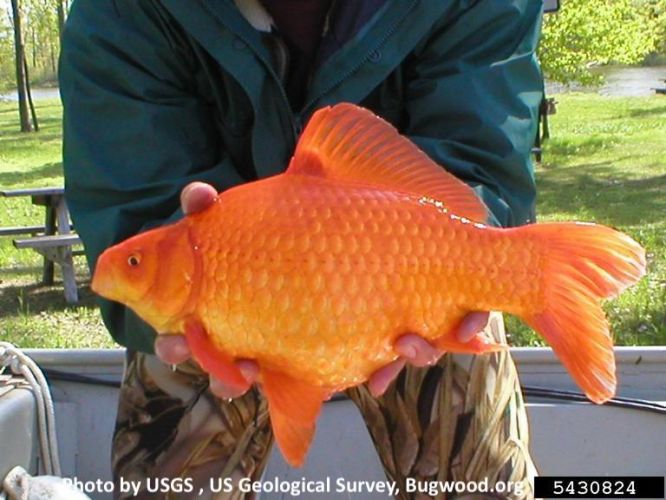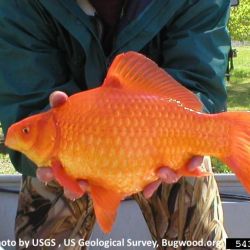
Priority: Prevent
General: An aquarium pet fish that comes in a variety of colours, often orange.
Size: On average, they are 12-22 cm long. They can grow up to 45cm long and weigh up to 3 kg if let loose into the wild under the optimal conditions.
Colour: Often bread to be orange in colour, they can be olive green or white.
Special Features: It has an elongated body, with a large head and small mouth. The head lacks scales. Fins with features that help to identify this species: Long dorsal (on its back) fin with a serrated spine and 15-21 rays. Side or lateral fin with 25-31 scales. Anal fin that is concave on males and convex on females.
Minnows, carp (Cyrinidae sp) and Koi.
Differences: Goldfish are different from Cyrinidae species because they have a dorsal fin larger then their head. The lack the barbels (“whiskers”) that the Koi fish have on their lower lip.
Where did it come from? Goldfish are native to easter Asia including China, Hong Kong, Japan and Korea. They have been released into waterbodies in BC.
Where does it live here? Goldfish can tolerate a wide variety of conditions and survive winter and ice cover. They like waterbodies with underwater vegetation and can live in streams, ponds, pools, and ditches.
Reproduction: Goldfish spawn eggs in shallow water with vegetation. They can lay up to several 100,000 eggs. One goldfish can live up to 30 years but on average live 7-10 years. One goldfish can spawn 3-10 groups of eggs every 8-10 days. They can produce large numbers in a short space of time.
When does it reproduce & mature? Eggs that are attached to vegetation hatch within 48-72 hours. In a week they begin to take a fish shape. It can take up to a year to become mature and ready to lay eggs.
Spreads By: Goldfish have been released by pet owners. They have also escaped from outdoor ponds. They easily become established once they are released and can spread into connected water bodies.
Species Type: Fish
- Once established in a water body, they can compete with the needs of native fish especially food.
- Goldfish can eat other native fish.
- Goldfish feeding causes sediment to be disturbed and increases water turbidity that could harm aquatic plants.
- They can carry diseases that can harm native fish populations.
- REPORT all sightings.
- Possession: Do not breed, ship or release Goldfish in BC.
- Pets: Don’t let any Goldfish loose because it may become invasive. Rehome an unwanted pet.
- CleanDrainDry your boat and gear to prevent the spread of goldfish or other aquatic invasives.
- Check all plants and soil for invasive hitch-hikers especially insects.
